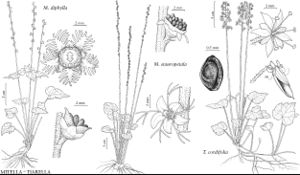Mitella
Sp. Pl. 1: 406. 1753.
Gen. Pl. ed. 5, 190. 1754 ,.
Herbs, rhizomatous, stoloniferous or not; caudex not cormlike, usually with persistent leaf bases. Flowering stems ascending or erect, leafy or leafless, (2–)6–55(–65) cm, subglabrous or short to long stipitate-glandular. Leaves in basal rosette and cauline; cauline leaves absent or 1–3, alternate or opposite; stipules present; petiole present, sometimes absent in cauline leaves, subglabrous or stipitate-glandular; blade ovate, cordate, or reniform, usually shallowly lobed, rarely unlobed, base cordate to truncate, margins crenate to dentate, apex acute, obtuse, or rounded, surfaces glabrous or subglabrous to variously stipitate-glandular; venation palmate. Inflorescences racemes, terminal from axillary buds in rosette, (scapose or leafy, anthesis usually acropetalous, basipetalous in M. caulescens, not secund to weakly secund or, rarely, strongly secund), 2–60-flowered, sometimes flowers solitary, bracteolate. Flowers: hypanthium adnate ± entire length of ovary, free from ovary to 1.5 mm, green, greenish white, or greenish yellow; sepals 5, white, greenish white, greenish, yellowish green, or greenish yellow, sometimes purple tinged; petals 5, greenish, greenish yellow, whitish green, or white, sometimes pink or purple tinged, (claw slender); nectariferous tissue proximal to stamens absent or obscure; stamens 5 or 10, opposite or alternate with sepals; filaments filiform; ovary nearly superior to nearly completely inferior, 1-locular, (2-lobed), carpels connate ± entire length, (equal); placentation parietal; styles 2; stigmas 2. Capsules obscurely 2-beaked, (dehiscent by adaxial sutures on free, lobed portion, dehiscent fruit sometimes appearing almost circumscissile). Seeds (4–40), reddish purple, dark reddish brown, or blackish, shiny, ellipsoid to ovoid, nearly smooth or pitted. x = 7.
Distribution
North America, Asia (China, Japan, Korea, Mongolia, Russia).
Discussion
Species ca. 20 (9 in the flora).
Mitella is treated here in the broad sense; phylogenetic data indicate that it is polyphyletic (D. E. Soltis et al. 1990; Soltis and R. K. Kuzoff 1995). Historically, four or five genera have been recognized (including Mitella, Ozomelis Rafinesque, Pectiantia Rafinesque). Formal restructuring of generic boundaries is complicated by the presence of nearly a dozen Asian species (M. Wakabayashi 2001) and lack of a comprehensive understanding of the genus relative to the rest of Saxifragaceae. Mitella nuda and M. diphylla, both with ten stamens, form a clade that would comprise a narrowly defined Mitella. A second clade composed of M. diversifolia, M. stauropetala, M. trifida, and Conimitella williamsii would form a second, distinct genus. Molecular data suggest that M. breweri, M. caulescens, and M. pentandra also form a distinct clade and perhaps a third, distinct genus. The relationships of M. ovalis are less certain; some analyses suggest that it may be sister to the genus Tolmiea (Soltis and Kuzoff; Kuzoff and Soltis, unpubl.).
Mitella diphylla exhibits splash-cup seed dispersal similar to Chrysosplenium (D. B. O. Savile 1953). Y. Okuyama et al. (2004) found that four Japanese species of Mitella are pollinated by fungus gnats, the pinnatifid petals of some species providing a resting platform for long- and spiny-legged flies. S. A. Spongberg (1972) reported syrphid flies and short-tongued bees as the most frequent visitors to M. diphylla.
In the keys and descriptions, leaf blade length is measured from the apex of the blade along the midvein proximally along the petiole to a perpendicular line that touches the proximal extension of the blade.
Selected References
Lower Taxa
Key
| 1 | Stamens 10; ovaries 1/3-1/2 inferior or nearly superior | > 2 |
| 1 | Stamens 5; ovaries 1/2 inferior to nearly completely inferior | > 3 |
| 2 | Cauline leaves absent or 1; plants usually stoloniferous; petals greenish yellow or greenish white. | Mitella nuda |
| 2 | Cauline leaves 2; plants not stoloniferous; petals white. | Mitella diphylla |
| 3 | Stamens alternate with sepals. | Mitella pentandra |
| 3 | Stamens opposite sepals | > 4 |
| 4 | Anthesis basipetalous; plants usually stoloniferous; cauline leaves 1-3; filaments usually purple proximally and white distally, sometimes entirely white; hypanthia 3-5.5 mm diam.; styles 0.8-1.1 mm, cylindric; stigmas unlobed. | Mitella caulescens |
| 4 | Anthesis acropetalous; plants not stoloniferous or, rarely, stoloniferous; cauline leaves absent or 1-2; filaments white or greenish; hypanthia 1.4-3.5 mm diam.; styles 0.1-0.3 mm, flattened; stigmas 2-lobed or unlobed | > 5 |
| 5 | Petals greenish yellow, blades lobed, lobes 3-11, linear; hypanthia saucer-shaped; sepals yellowish green or greenish, triangular to broadly triangular, spreading to recurved | > 6 |
| 5 | Petals white, sometimes pink- or purple-tinged, blades lobed or, sometimes, unlobed, lobes 3-5, linear to lanceolate; hypanthia campanulate, obconic-campanulate, or turbinate-campanulate; sepals whitish, greenish white, or purple-tinged, oblong, oblong-ovate, widely ovate, triangular-ovate, or triangular, erect or spreading | > 7 |
| 6 | Leaf blades broadly cordate to reniform, usually shorter than or sometimes ± as long as wide, 1.5-7.9 × 1.5-11 cm, surfaces glabrous or sparsely short stipitate-glandular and sparsely long stipitate-glandular; petioles of basal leaves subglabrous or stipitate-glandular and sparsely long stipitate-glandular. | Mitella breweri |
| 6 | Leaf blades cordate-ovate to cordate-oblong, longer than wide, 2.7-7 × 1.5-5.4 cm, surfaces sparsely stipitate-glandular and long stipitate-glandular to sparsely long stipitate-glandular along primary veins abaxially, stipitate-glandular adaxially; petioles of basal leaves short stipitate-glandular and densely long stipitate-glandular. | Mitella ovalis |
| 7 | Leaf blades longer than or ± as long as wide, cordate-ovate or triangular-cordate, apex of terminal lobe acute; flowers 1(-2) per node; cauline leaves absent or 1-2. | Mitella diversifolia |
| 7 | Leaf blades shorter than or sometimes ± as long as wide, cordate, cordate-ovate, or reniform, apex of terminal lobe rounded to obtuse; flowers 1 per node; cauline leaves absent | > 8 |
| 8 | Racemes strongly secund, 10-45-flowered; petals linear to lanceolate, lateral lobes ascending or spreading. | Mitella stauropetala |
| 8 | Racemes weakly secund or not secund, 4-20-flowered; petals lanceolate, lateral lobes ascending. | Mitella trifida |
